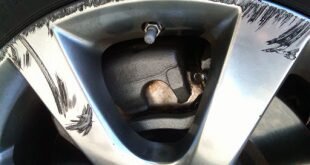Why Alloy Wheel Refurbishment is About More Than Just Good Looks

Alloys have become the ultimate status symbol for your car. If you want your ride to look its best, you simply have to invest in a set of quality alloy rims.
But keeping up appearances isn’t the only reason to opt for alloy wheels. Compared to standard steel wheels, they offer several benefits. For one, alloys are much lighter than steel. Lowering the overall weight of your car improves performance in a number of ways, such as better fuel economy, better handling around bends, enhanced acceleration and less wear on brakes.
These are all reasons why alloys are the preferred choice on high-end sports and performance cars.
At the same time, despite being lighter than steel, alloys often have a higher tensile strength. An alloy is a mix of several metals. The alloys used for car wheels often contain aluminium and magnesium, both known for being soft metals. But when blended together, they produce a material that is tough and resilient.
But tough and resilient as alloy wheels are, they aren’t immune to the wear and tear of the roads. The wheels of your car take more of a hammering than any other part of the vehicle.
It’s them that are in constant contact with the road. It’s them that rotate at high speeds to make your car move. It’s them that bear the brunt of the dirt, grit, debris and all the impacts with uneven surfaces.
You can’t always tell if alloy wheels are damaged solely from a casual inspection, or how deep the damage goes. That poses problems. For one, damage to alloys can cancel out all the performance benefits they offer. But most importantly, it can make your car dangerous to drive.
That’s why it’s important to get your alloy wheels professionally checked on a regular basis. You want to get your car booked in for alloy wheel repair at the first sign of any damage. It’s much cheaper if you catch problems early. Leave them unresolved, and you risk much wider structural damage to the rest of your car.
Impact damage
The most common cause of damage to alloy wheels is impact. This might be the result of driving over potholes in the road, clipping the curb, or driving over a speed bump too fast.
There are a couple of things that an impact can do to damage your alloys. One, it can cause them to crack directly. Cracks don’t have to be visible from the outside. The damage could be hidden from sight on the blind side of the rim.
The big danger with unseen cracks is that they will develop over time. Even a very minor nick can end up turning into a major problem. All the stress and strain your wheels are under, any defect will only get worse over time.
If you do knock your wheels while driving, you’d be advised to book your car in to get the alloys tested for cracks. It’s much better to catch them sooner rather than later. Another telltale sign of damaged alloys is your tyre pressure going down very slowly. You might assume it’s a slow puncture, but it could be a hairline fracture meaning your alloys aren’t applying enough pressure to the inside of the tyre.
The second way impact can damage your wheels is by knocking the alloys out of alignment. If the force is enough to buckle the wheel completely, then your tyre will deflate more or less instantaneously, just like a blow out. But less severe impacts, such as hitting a pothole, could cause only a very slight loss of alignment between tyre and wheel.
Again, the problems this will cause will develop over time. At first it will mainly be a drag on performance as your wheel spins less efficiently, causing the engine to work harder. As time goes on, you might notice handling suffer, and could even experience issues with braking.
Wheel alignment and balancing
Wheel alignment and balancing are two important parts of wheel repairs. They aren’t specific to alloys, but play a vital role in ensuring your vehicle is safe to drive and performs at its best on the road.
The two are often confused. Wheel alignment is all about making sure wheels are lined up in relation to one another. Correct alignment is achieved by adjusting the angles of several component parts. The correct angles are model and manufacturer specific. The main purpose of wheel alignment is to keep you straight when you are not steering.
Wheel balancing, on the other hand, is about weight distribution through the wheel. If weight isn’t balanced through the wheel evenly, the tyres won’t spin as well as they should do. You will also feel effects like vibrations through the steering wheel which can get very uncomfortable.

